 |
 |
 |
| |
SCH-900518 New Schering Protease Inhibitor
Monotherapy & with Peg/RBV 7-14 days
|
| |
| |
See pics of slides below
EASL April 23-26 2009
Copenhagen, Denmark
Reported by Jules Levin
Replicon activity of SCH900518, the new protease inibitor from Schering-Plough, demonstrates potency: EC50 = 2- nM, EC90 = 40 nM. Treatment naive and experienced patients were studied with 800 mg tid (3x/daily) and 400 mg bid + 200 mg ritonavir bid. The number of patients is small but perhaps diarrhea was associated with RTV use. The PK chart showed double the levels of the 400 mg bid + RTV compared to 800 mg tid. The trough levels were 61 x EC90 for the RTV boosted group and 11 x EC90 for the unboosted regimen. Mean viral load reductions were about 5 logs for unboosted SCH900518, perhaps it could have been greater but it appeared to me that due to baseline levels reduction in viral load hit as lower level of detection. The boosted regimen did not achieve as much viral load reduction. This could be because patients received monotherapy for 7 days before receiving triple therapy including Peg/RBV for another 14 days and resistance was actually detected in these patients. Viral load reduction was about 3.5 logs for the 400mg/RTV bid treatment experienced group and this also could be because they did not respond well to peg/RBV. Treatment-naives who received 400mg/RTV bid achieved about a 4 log reduction. They modeled SCH90518 tablet + RTV PK for phase 2 study and 200mg once daily/RTV produced trough levels 8 x EC(90, 400mg qd/RTV produced trough levels 16 x EC90, and 100 mg bid/RTV produced trough levels 12 x EC90. They reported preliminary phase II data where patients received 200 mg SCH900518 + 100 mg RTV once daily + Peg/RBV. Viral load reductions were 19/20 (95%) < LLQ (25 IU/ml) and 15/20 (75%) < LLD (9.3 IU/ml) at 30 days although it appeared they reached undetectable by day 15. The authors concluded "SCH900518 exhibited potent activity in both treatment experienced and treatment-naive. PK and PD modeling, as well as preliminary in-treatment antiviral data, support once-daily dosing with metabolic inhibition".
Presentation Date: Apr 24, 2009
SAFETY AND ANTIVIRAL ACTIVITY OF SCH 900518 ADMINISTERED AS MONOTHERAPY AND IN COMBINATION WITH PEGINTERFERON ALFA-2B TO NAÏVE AND TREATMENT-EXPERIENCED HCV-1 INFECTED PATIENTS
H. Reesink1, J. Bergmann2, J. de Bruijne1, C. Weegink1, J. van Lier3, A. van Vliet3, A. Keung4, J. Li4, E. O'Mara4, M. Treitel4, E. Hughes4, H. Janssen2, R. de Knegt2
1Hepatology, Academic Medical Center, Amsterdam, 2Hepatology, Erasmus MC University Hospital, Rotterdam,3PRA, PRA International, Zuidlaren, The Netherlands, 4SPRI, Schering-Plough, Kenilworth, NJ, USA
Background: SCH 900518, a novel HCV NS3 protease inhibitor, demonstrates potent antiviral activity (EC90 of 40 nM). This study explored the safety and antiviral activity of SCH 900518, administered as monotherapy and combination therapy with PegIntron (± ritonavir) to HCV genotype 1 infected patients.
Methods: This was a two period study in HCV genotype 1 infected subjects (naÏve and treatment-experienced). SCH 900518 was administered as an suspension for 7 days (800 mg TID or 400 mg BID with ritonavir). After a 4 week washout, SCH 900518 was administered at the same dose in combination with PegIntron for 14 days. Safety, PK, and antiviral activity were assessed. After the study, all patients initiated SOC treatment.
Results: Forty subjects completed the study. SCH 900518 (± ritonavir) alone or in combination with PegIntron was found to be well tolerated. Both dose regimens resulted in trough plasma concentrations of SCH 900518 above the EC90 as determined by the HCV replicon assay. There were no clinically significant changes from baseline in vital signs, laboratory values, or ECGs. The majority of AEs were mild or moderate. An SAE of fever occurred during follow-up (treatment with PegIntron and ribavirin only) and was unlikely related to SCH 900518. A rapid and continuous decline in plasma HCV RNA was observed in both treatment-experienced and naive subjects during 7 days of SCH 900518 monotherapy (± ritonavir). A high percentage of both treatment-experienced and naÏve patients had plasma HCV RNA below the LLQ (< 25 IU/mL) during combination therapy with PegIntron (± ritonavir) on Day 15 (see table).
Conclusions: SCH 900518 administered alone or in combination with PegIntron was safe and well tolerated. Robust reductions in plasma HCV RNA levels were achieved in both treatment-experienced and naÏve HCV genotype 1-infected patients.

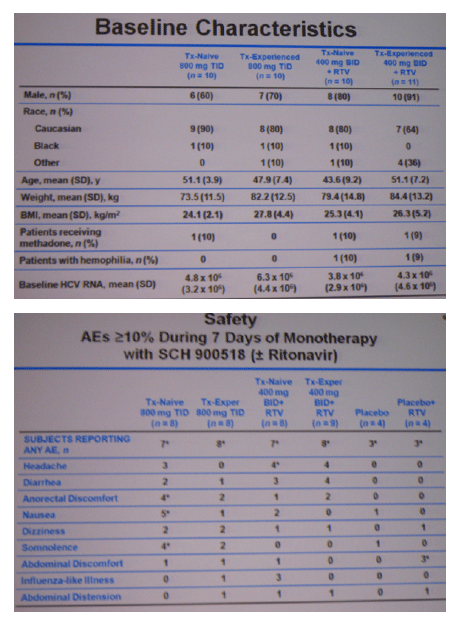
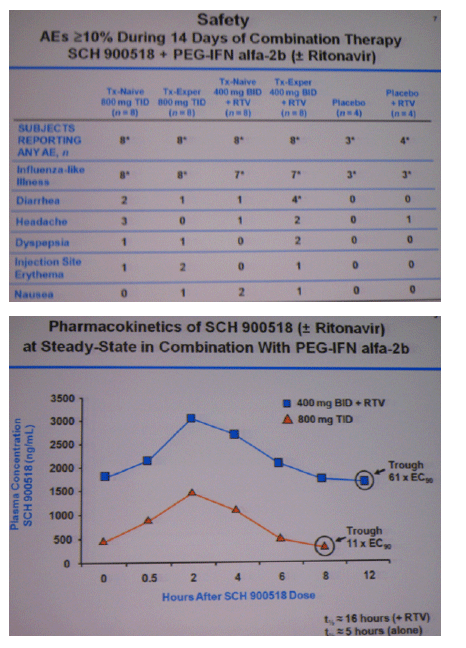
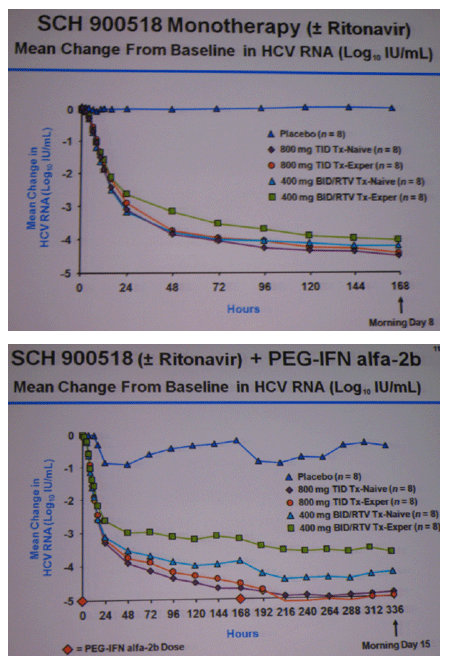
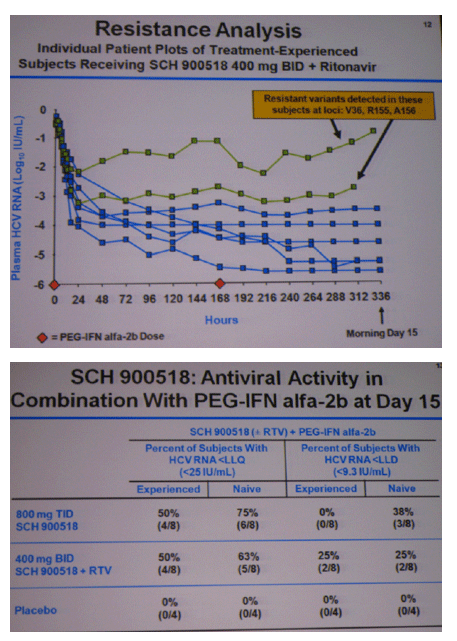
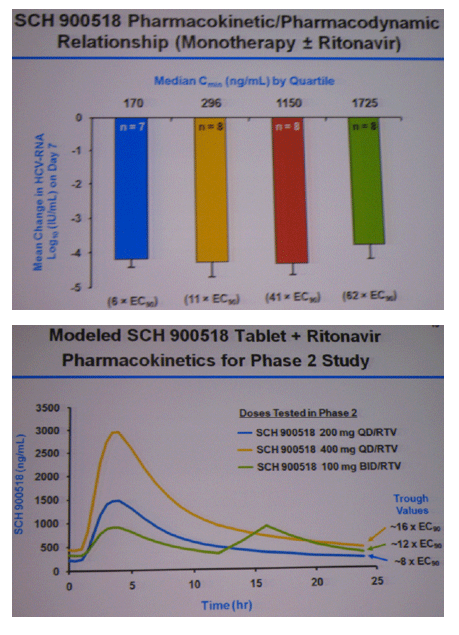
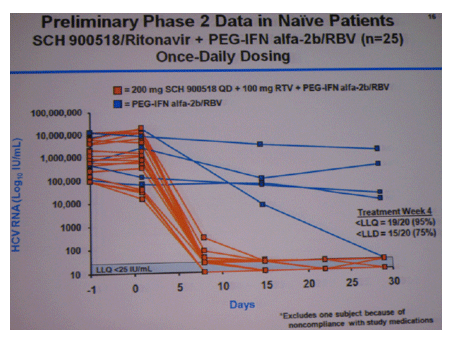
|
| |
|
 |
 |
|
|